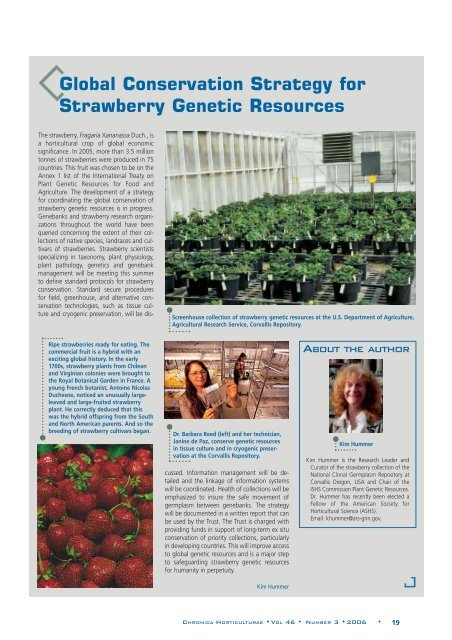Acta Horticulturae
Acta Horticulturae
Acta Horticulturae
Create successful ePaper yourself
Turn your PDF publications into a flip-book with our unique Google optimized e-Paper software.
Global Conservation Strategy for<br />
Strawberry Genetic Resources<br />
The strawberry, Fragaria Xananassa Duch., is<br />
a horticultural crop of global economic<br />
significance. In 2005, more than 3.5 million<br />
tonnes of strawberries were produced in 75<br />
countries. This fruit was chosen to be on the<br />
Annex 1 list of the International Treaty on<br />
Plant Genetic Resources for Food and<br />
Agriculture. The development of a strategy<br />
for coordinating the global conservation of<br />
strawberry genetic resources is in progress.<br />
Genebanks and strawberry research organizations<br />
throughout the world have been<br />
queried concerning the extent of their collections<br />
of native species, landraces and cultivars<br />
of strawberries. Strawberry scientists<br />
specializing in taxonomy, plant physiology,<br />
plant pathology, genetics and genebank<br />
management will be meeting this summer<br />
to define standard protocols for strawberry<br />
conservation. Standard secure procedures<br />
for field, greenhouse, and alternative conservation<br />
technologies, such as tissue culture<br />
and cryogenic preservation, will be dis-<br />
Screenhouse collection of strawberry genetic resources at the U.S. Department of Agriculture,<br />
Agricultural Research Service, Corvallis Repository.<br />
Ripe strawberries ready for eating. The<br />
commercial fruit is a hybrid with an<br />
exciting global history. In the early<br />
1700s, strawberry plants from Chilean<br />
and Virginian colonies were brought to<br />
the Royal Botanical Garden in France. A<br />
young French botanist, Antoine Nicolas<br />
Duchesne, noticed an unusually largeleaved<br />
and large-fruited strawberry<br />
plant. He correctly deduced that this<br />
was the hybrid offspring from the South<br />
and North American parents. And so the<br />
breeding of strawberry cultivars began.<br />
Dr. Barbara Reed (left) and her technician,<br />
Janine de Paz, conserve genetic resources<br />
in tissue culture and in cryogenic preservation<br />
at the Corvallis Repository.<br />
cussed. Information management will be detailed<br />
and the linkage of information systems<br />
will be coordinated. Health of collections will be<br />
emphasized to insure the safe movement of<br />
germplasm between genebanks. The strategy<br />
will be documented in a written report that can<br />
be used by the Trust. The Trust is charged with<br />
providing funds in support of long-term ex situ<br />
conservation of priority collections, particularly<br />
in developing countries. This will improve access<br />
to global genetic resources and is a major step<br />
to safeguarding strawberry genetic resources<br />
for humanity in perpetuity.<br />
Kim Hummer<br />
ABOUT THE AUTHOR<br />
Kim Hummer<br />
Kim Hummer is the Research Leader and<br />
Curator of the strawberry collection of the<br />
National Clonal Germplasm Repository at<br />
Corvallis Oregon, USA and Chair of the<br />
ISHS Commission Plant Genetic Resources.<br />
Dr. Hummer has recently been elected a<br />
Fellow of the American Society for<br />
Horticultural Science (ASHS).<br />
Email: khummer@ars-grin.gov.<br />
CHRONICA HORTICULTURAE •VOL 46 • NUMBER 3 • 2006 • 19
















